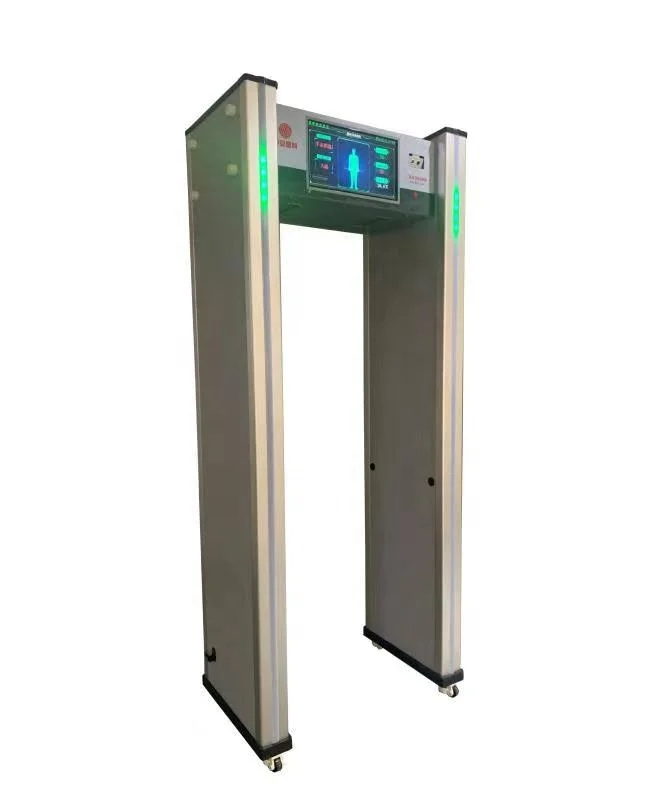Table of Contents
วิธีหนึ่งที่เครื่องตรวจจับโลหะแบบเดินผ่านสามารถตรวจจับอะลูมิเนียมได้คือการใช้คอยล์ตรวจจับหลายตัว คอยล์เหล่านี้สร้างสนามแม่เหล็กไฟฟ้าที่ความถี่ต่างกัน ช่วยให้เครื่องตรวจจับสามารถแยกแยะระหว่างโลหะประเภทต่างๆ ได้ เมื่ออะลูมิเนียมผ่านเครื่องตรวจจับ จะรบกวนสนามแม่เหล็กไฟฟ้าในลักษณะเฉพาะที่ระบบสามารถระบุได้
อีกวิธีหนึ่งที่เครื่องตรวจจับโลหะแบบเดินผ่านใช้เพื่อตรวจจับอะลูมิเนียมคือการใช้เทคโนโลยีการเหนี่ยวนำพัลส์ เทคโนโลยีนี้จะส่งคลื่นแม่เหล็กไฟฟ้าสั้นๆ ลงสู่พื้น และเมื่อมีวัตถุที่เป็นโลหะ เช่น อะลูมิเนียม ก็จะสร้างสัญญาณสะท้อนที่เครื่องตรวจจับจับขึ้นมา ซึ่งช่วยให้ระบบสามารถระบุการมีอยู่ของอะลูมิเนียมได้แม้ว่าจะไม่ใช่แม่เหล็กก็ตาม
แม้จะมีความท้าทายที่เกิดจากคุณสมบัติที่ไม่ใช่แม่เหล็กของอะลูมิเนียม แต่เครื่องตรวจจับโลหะแบบเดินผ่านยังคงมีประสิทธิภาพในการตรวจจับโลหะนี้ เทคโนโลยีขั้นสูงและวิธีการตรวจจับหลายวิธีที่ใช้ในอุปกรณ์เหล่านี้ช่วยให้แน่ใจว่าวัตถุที่เป็นอะลูมิเนียมจะไม่ถูกมองข้ามในระหว่างการคัดกรองความปลอดภัย
การใช้อะลูมิเนียมในผลิตภัณฑ์ได้รับความนิยมมากขึ้นเนื่องจากมีข้อดีหลายประการ แต่จำเป็นอย่างยิ่งที่จะต้องพิจารณาว่าวัสดุนี้สามารถ ส่งผลต่อการคัดกรองเครื่องตรวจจับโลหะ แม้ว่าเครื่องตรวจจับโลหะแบบเดินผ่านสามารถตรวจจับอะลูมิเนียมได้ แต่เจ้าหน้าที่รักษาความปลอดภัยจำเป็นต้องตระหนักถึงสิ่งนี้และปรับขั้นตอนการคัดกรองให้เหมาะสม
โดยสรุป เครื่องตรวจจับโลหะแบบเดินผ่านสามารถตรวจจับอะลูมิเนียมได้แม้จะมีคุณสมบัติไม่เป็นแม่เหล็กก็ตาม . เทคโนโลยีขั้นสูงและวิธีการตรวจจับหลายวิธีที่ใช้ในอุปกรณ์เหล่านี้ช่วยให้สามารถคัดกรองโลหะประเภทต่างๆ รวมถึงอลูมิเนียมได้อย่างมีประสิทธิภาพ เนื่องจากการใช้อะลูมิเนียมในผลิตภัณฑ์ยังคงเติบโตอย่างต่อเนื่อง จึงจำเป็นอย่างยิ่งที่เจ้าหน้าที่รักษาความปลอดภัยจะต้องเข้าใจว่าวัสดุนี้อาจส่งผลกระทบต่อการคัดกรองเครื่องตรวจจับโลหะอย่างไร และเพื่อให้แน่ใจว่ามีขั้นตอนที่เหมาะสมในการตรวจจับวัตถุโลหะทุกประเภท
ความเข้าใจผิดที่พบบ่อยเกี่ยวกับเครื่องตรวจจับอลูมิเนียมและโลหะ
ปัจจัยสำคัญในการพิจารณาว่าเครื่องตรวจจับโลหะสามารถตรวจจับอะลูมิเนียมได้หรือไม่คือการตั้งค่าความไวของอุปกรณ์ เครื่องตรวจจับโลหะแบบเดินผ่านส่วนใหญ่มาพร้อมกับระดับความไวที่ปรับได้ ซึ่งสามารถปรับแต่งเพื่อตรวจจับโลหะประเภทเฉพาะได้ ด้วยการปรับการตั้งค่าความไว เจ้าหน้าที่รักษาความปลอดภัยสามารถปรับเทียบเครื่องตรวจจับโลหะเพื่อตรวจจับโลหะที่ไม่ใช่เหล็ก เช่น อะลูมิเนียม
นอกเหนือจากการตั้งค่าความไวแล้ว ขนาดและความหนาของวัตถุอะลูมิเนียมยังมีบทบาทสำคัญในว่าจะสามารถตรวจจับได้โดย เครื่องตรวจจับโลหะ วัตถุอะลูมิเนียมที่มีขนาดใหญ่กว่าและหนากว่ามีแนวโน้มที่จะตรวจพบได้ง่ายกว่าวัตถุที่มีขนาดเล็กและบางกว่า เนื่องจากวัตถุขนาดใหญ่มีพื้นที่ผิวให้เครื่องตรวจจับโลหะจับได้มากกว่า ทำให้ตรวจจับได้ง่ายขึ้น
ปัจจัยสำคัญอีกประการหนึ่งที่ต้องพิจารณาคือความถี่ของเครื่องตรวจจับโลหะ เครื่องตรวจจับโลหะประเภทต่างๆ ทำงานที่ความถี่ต่างกัน ซึ่งอาจส่งผลต่อความสามารถในการตรวจจับโลหะบางชนิดได้ เครื่องตรวจจับโลหะบางรุ่นได้รับการออกแบบมาโดยเฉพาะเพื่อตรวจจับโลหะที่ไม่ใช่เหล็ก เช่น อะลูมิเนียม ในขณะที่บางรุ่นอาจจับวัสดุเหล่านี้ได้ยากกว่า สิ่งสำคัญคือต้องเลือกเครื่องตรวจจับโลหะที่มีความถี่ที่เหมาะสมสำหรับประเภทโลหะที่คุณต้องการตรวจจับ
และควรสังเกตด้วยว่าเครื่องตรวจจับโลหะแบบเดินผ่านไม่ใช่เทคโนโลยีการตรวจจับโลหะประเภทเดียวที่มีให้บริการ เครื่องตรวจจับโลหะแบบมือถือหรือที่เรียกว่าเครื่องตรวจจับโลหะแบบด้าม มักใช้ร่วมกับเครื่องตรวจจับโลหะแบบเดินผ่านเพื่อให้กระบวนการคัดกรองละเอียดยิ่งขึ้น เครื่องตรวจจับแบบมือถือมีความไวสูงและสามารถตรวจจับโลหะจำนวนเล็กน้อย รวมทั้งอะลูมิเนียม ได้อย่างง่ายดาย
โดยสรุป เครื่องตรวจจับโลหะแบบเดินผ่านสามารถตรวจจับอะลูมิเนียมได้ แม้ว่าจะมีความเข้าใจผิดทั่วไปว่าไม่สามารถทำได้ก็ตาม ด้วยการปรับการตั้งค่าความไว โดยคำนึงถึงขนาดและความหนาของวัตถุอะลูมิเนียม และการเลือกความถี่ที่เหมาะสม เจ้าหน้าที่รักษาความปลอดภัยจึงสามารถตรวจจับโลหะที่ไม่ใช่เหล็ก เช่น อลูมิเนียมได้อย่างมีประสิทธิภาพ นอกจากนี้ เครื่องตรวจจับโลหะแบบมือถือยังสามารถใช้ร่วมกับเครื่องตรวจจับแบบเดินผ่านเพื่อเพิ่มประสิทธิภาพกระบวนการคัดกรอง การทำความเข้าใจความสามารถของเครื่องตรวจจับโลหะและวิธีการทำงานถือเป็นสิ่งสำคัญในการรักษาสภาพแวดล้อมที่ปลอดภัยสำหรับทุกคน
Common Misconceptions About Aluminum and Metal Detectors
Metal detectors are commonly used in various settings, such as airports, schools, and government buildings, to ensure the Safety and Security of individuals entering the premises. One common misconception about metal detectors is whether they can detect aluminum. In this article, we will explore the truth behind this misconception and provide a better understanding of how walk-through metal detectors work.
Aluminum is a lightweight metal that is commonly used in everyday items such as beverage cans, foil, and cookware. Due to its non-ferrous properties, aluminum is often mistakenly believed to be undetectable by metal detectors. However, this is not entirely true. While it is true that walk-through metal detectors are primarily designed to detect ferrous metals such as Iron and steel, they are also capable of detecting non-ferrous metals like aluminum.

The key factor in determining whether a metal detector can detect aluminum is the sensitivity settings of the device. Most walk-through metal detectors are equipped with adjustable sensitivity Levels that can be customized to detect specific types of metals. By adjusting the sensitivity settings, security personnel can calibrate the metal detector to detect non-ferrous metals like aluminum.
In addition to sensitivity settings, the size and thickness of the aluminum object also play a significant role in whether it can be detected by a metal detector. Larger and thicker aluminum objects are more likely to be detected than smaller and thinner ones. This is because larger objects have a greater surface area for the metal detector to pick up on, making them easier to detect.
Another important factor to consider is the frequency of the metal detector. Different types of metal detectors operate at different frequencies, which can affect their ability to detect certain metals. Some metal detectors are specifically designed to detect non-ferrous metals like aluminum, while others may have a harder time picking up on these materials. It is essential to choose a metal detector with the appropriate frequency for the types of metals you are looking to detect.
It is also worth noting that walk-through metal detectors are not the only type of metal detection technology available. Handheld metal detectors, also known as wand detectors, are commonly used in conjunction with walk-through metal detectors to provide a more thorough screening process. Handheld detectors are highly sensitive and can easily detect small amounts of metal, including aluminum.
In conclusion, walk-through metal detectors are capable of detecting aluminum, despite the common misconception that they cannot. By adjusting the sensitivity settings, considering the size and thickness of the aluminum object, and choosing the appropriate frequency, security personnel can effectively detect non-ferrous metals like aluminum. Additionally, handheld metal detectors can be used in conjunction with walk-through detectors to enhance the screening process. Understanding the capabilities of metal detectors and how they work is essential for maintaining a safe and secure Environment for all individuals.
